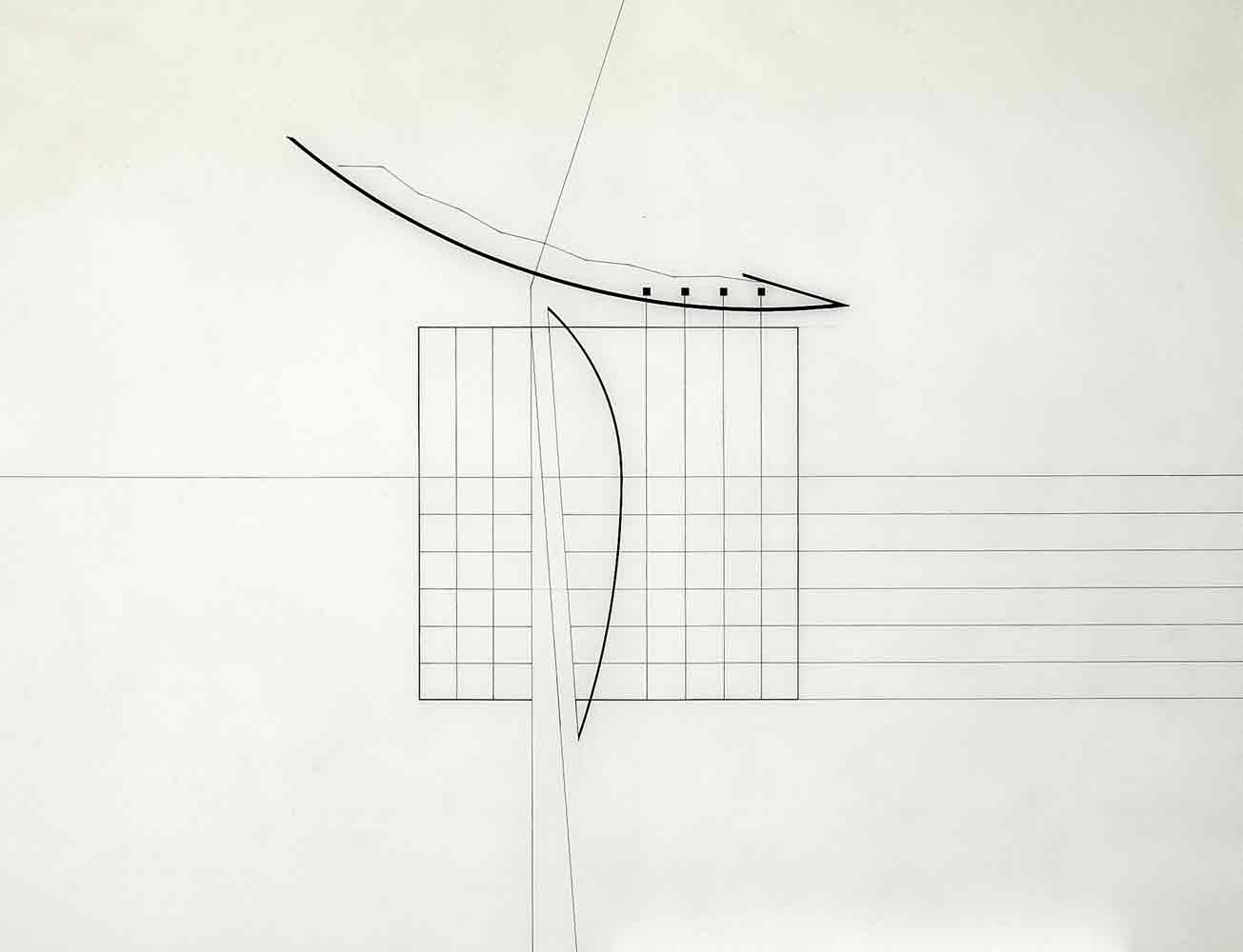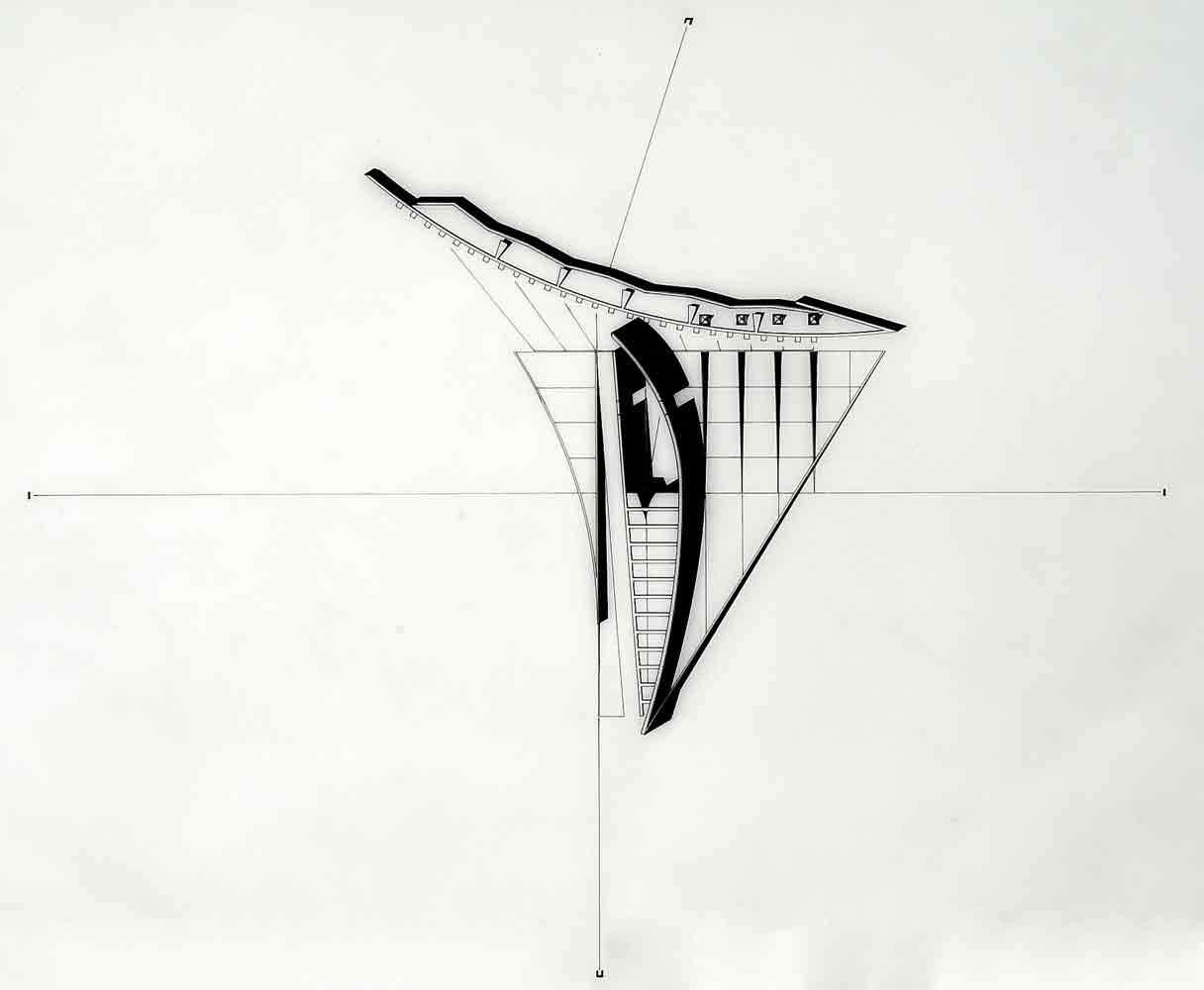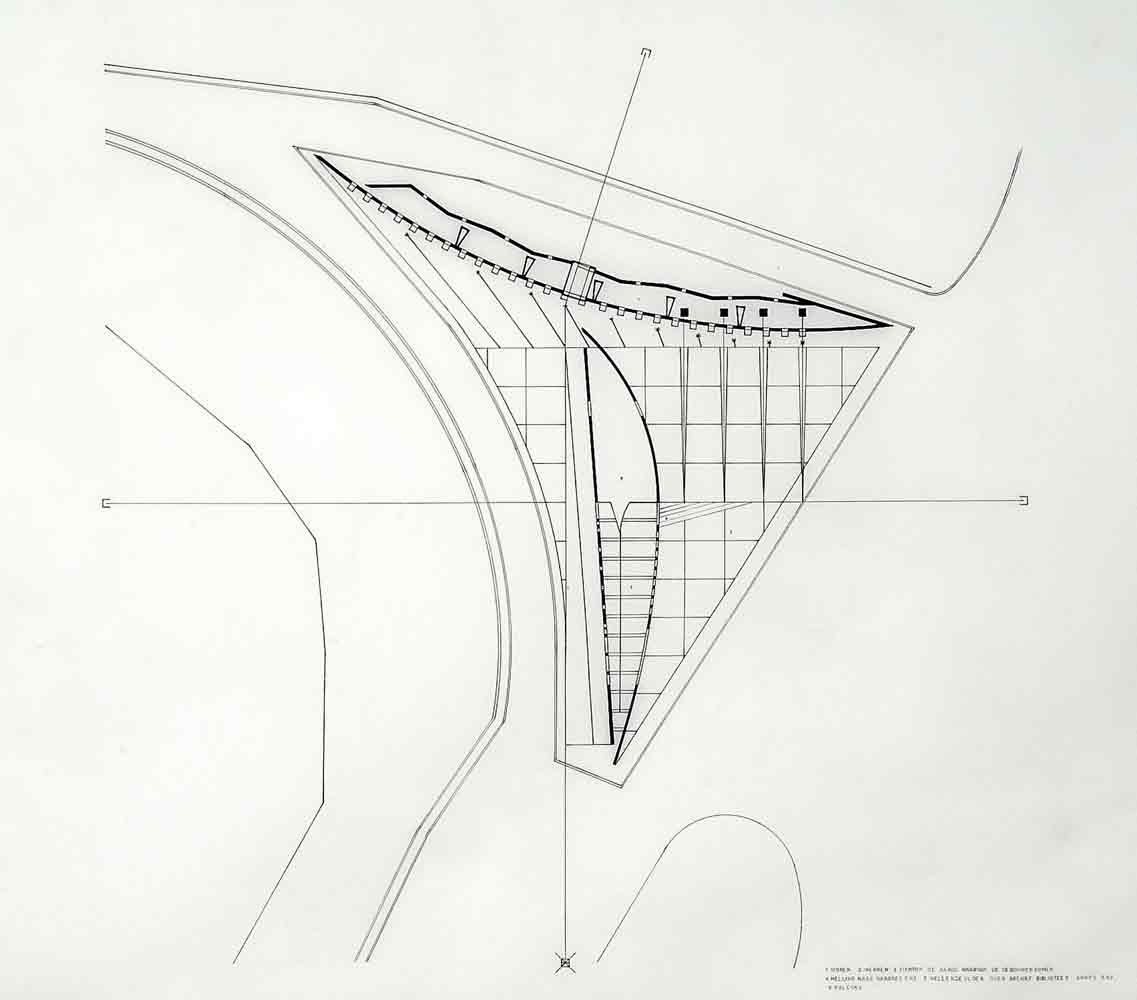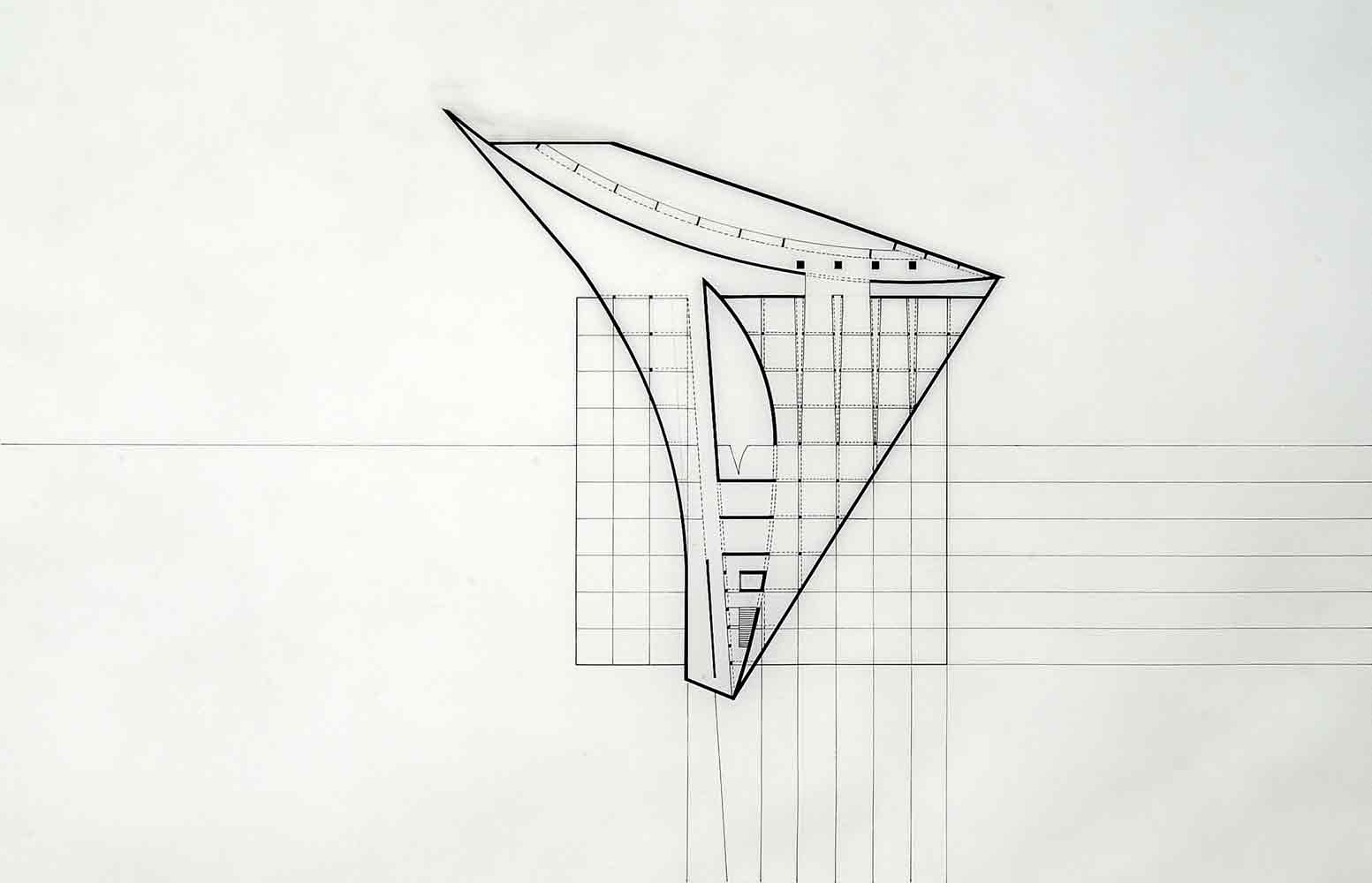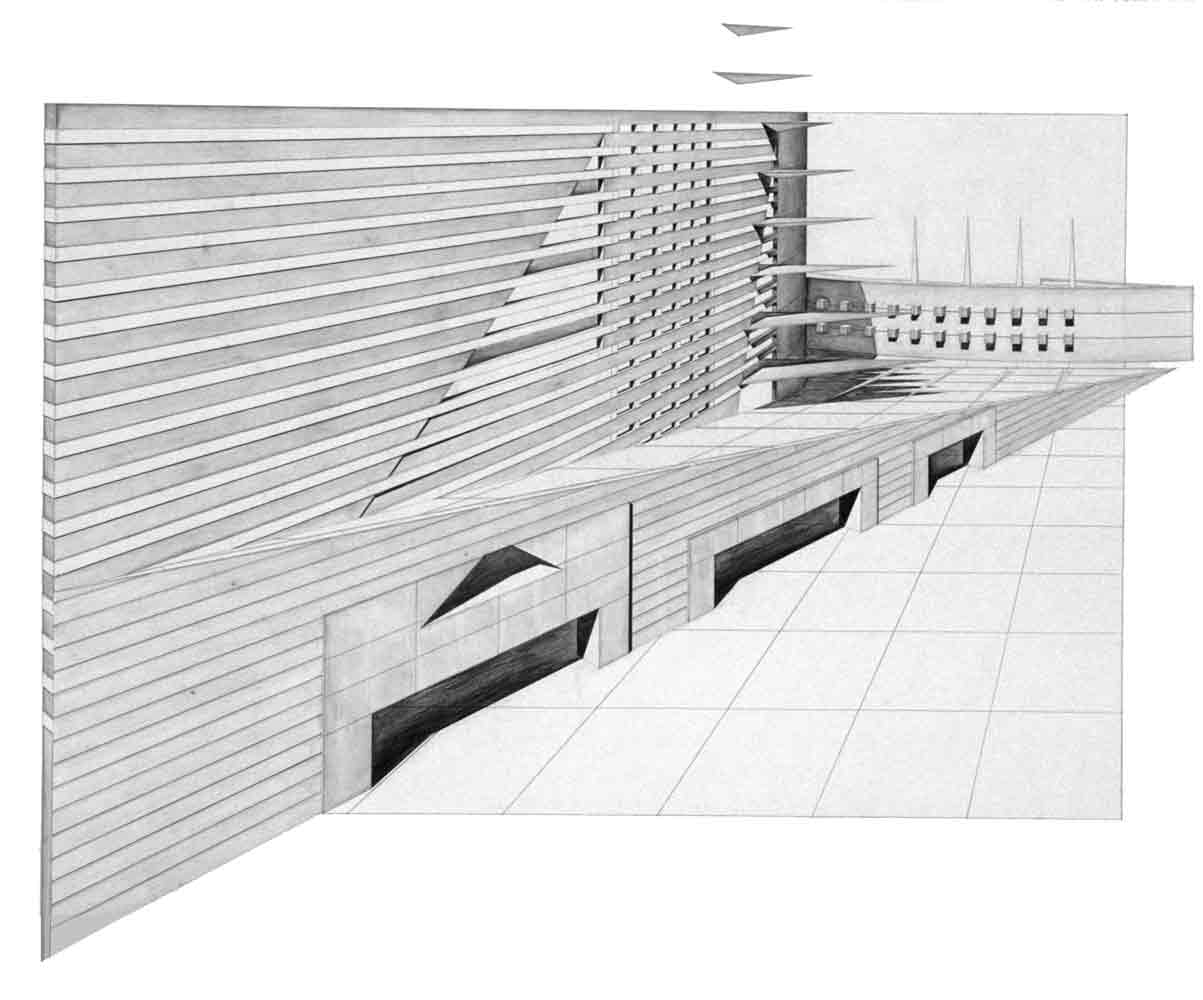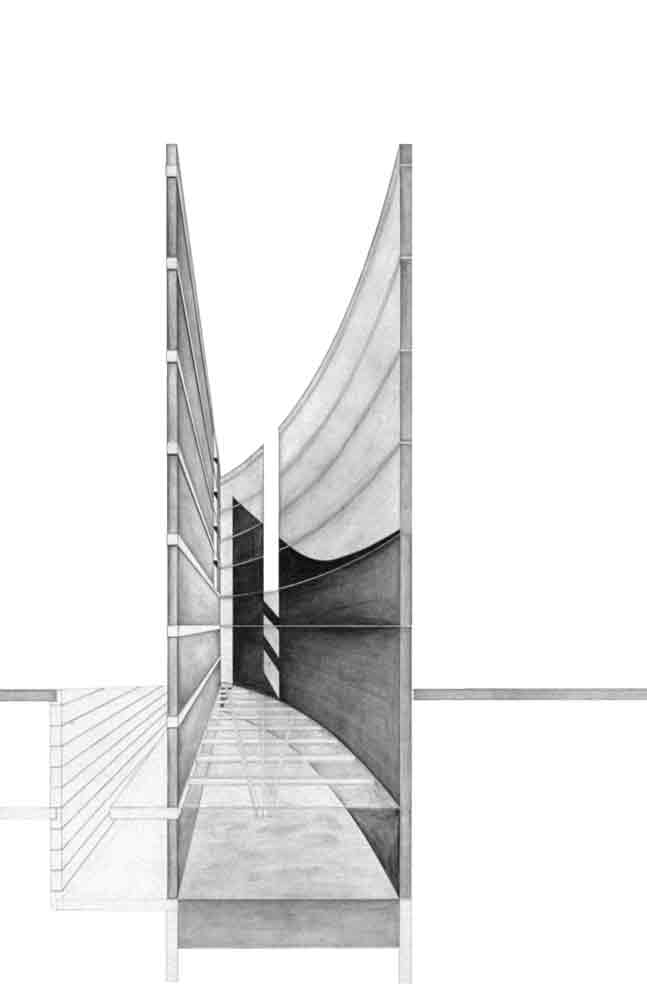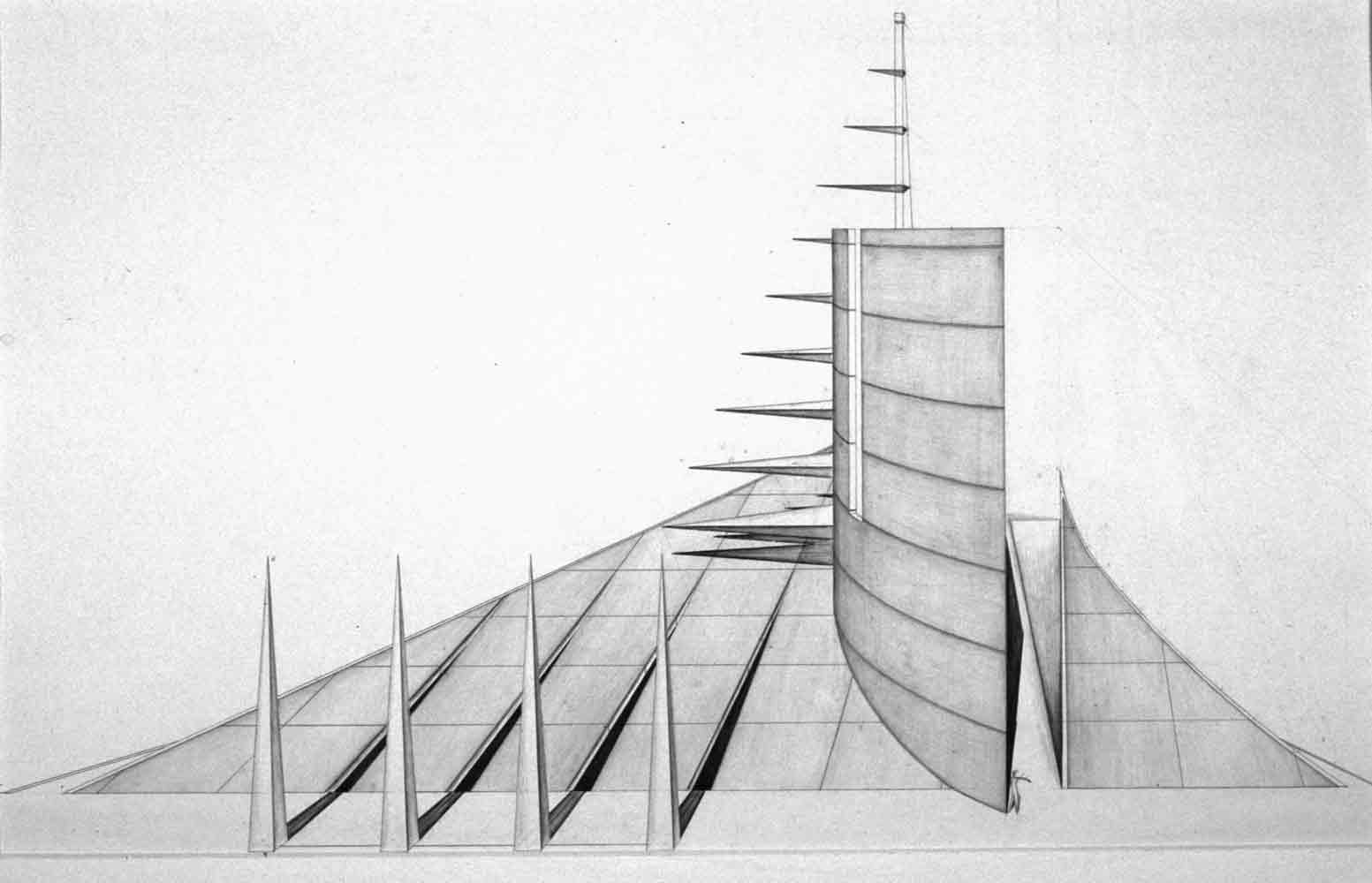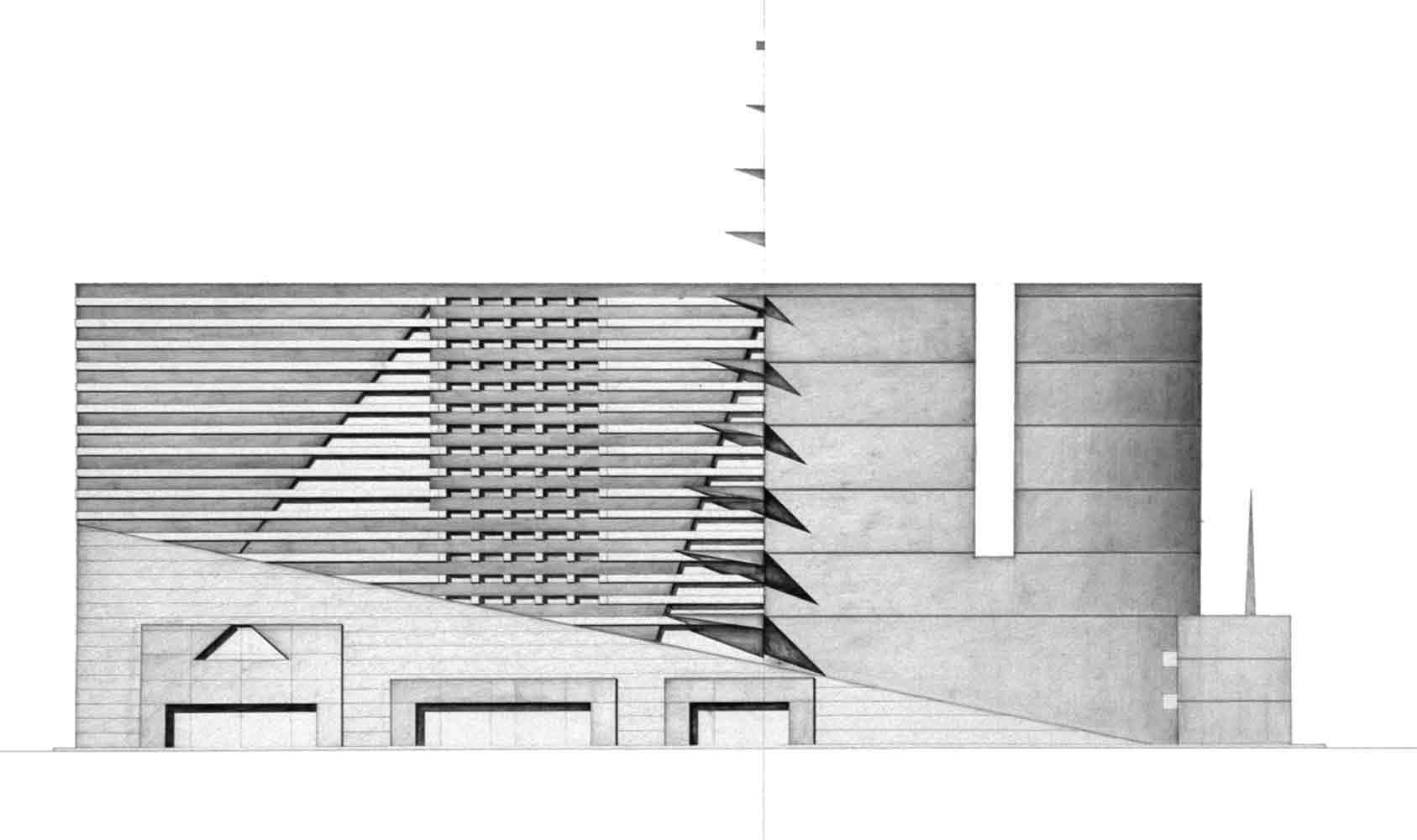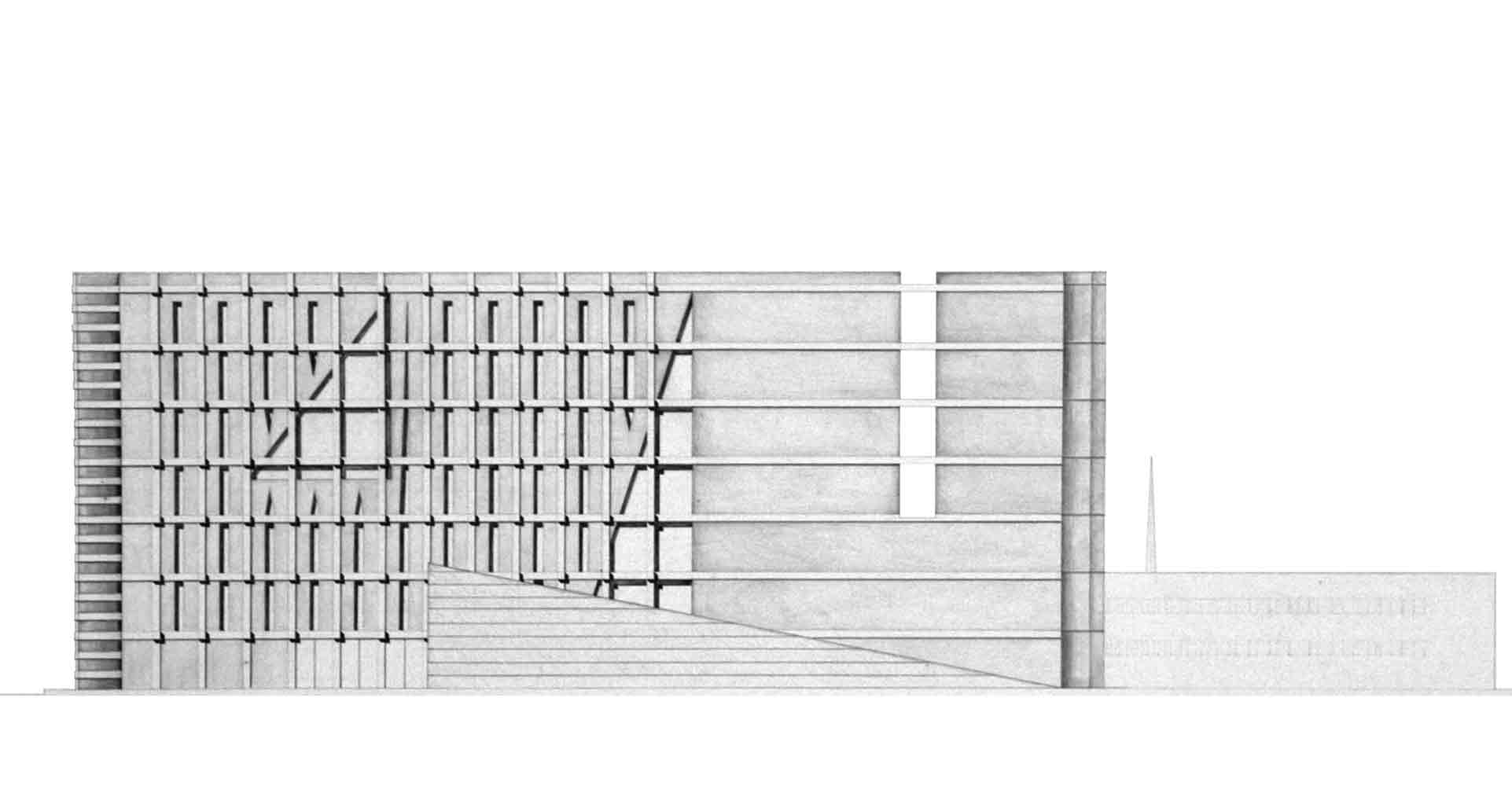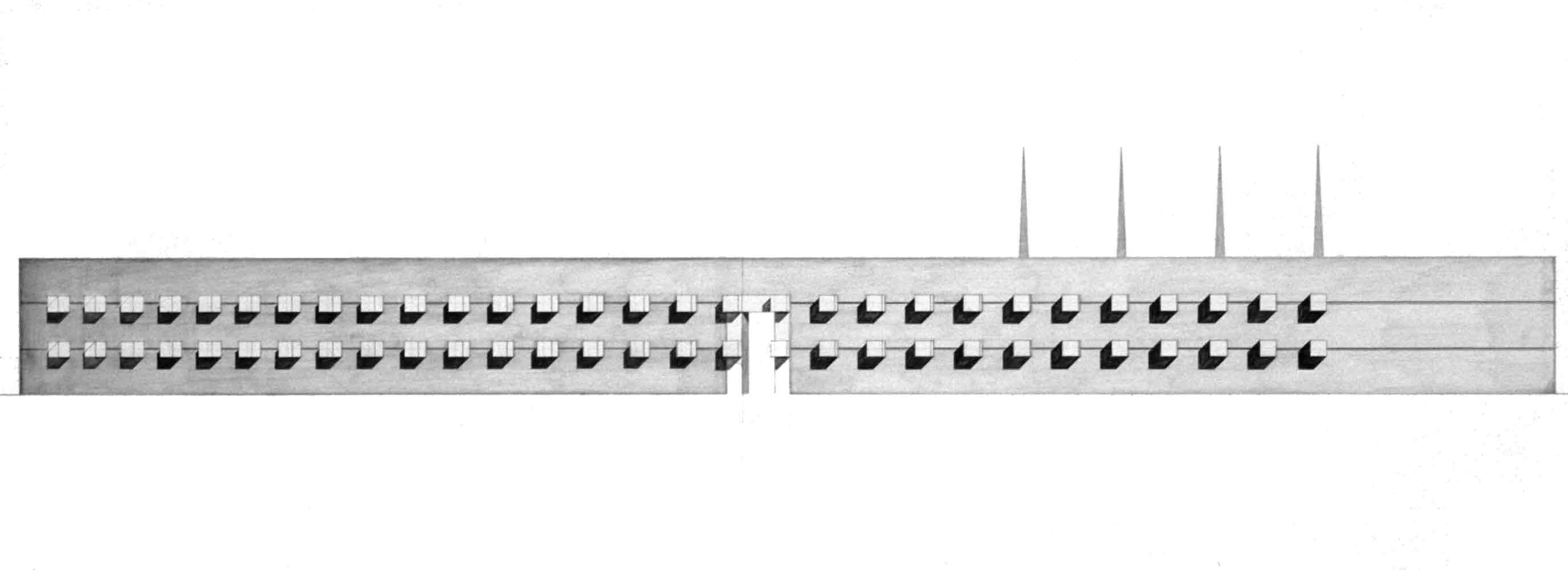1997 Gand
Small competition at the entrance to Ghent in Belgium.... :
A house of architects....
Meeting places, information places, library,
accommodations for researchers....
Administration....Parking....
*
But first a little warning.
The following text is a translation, made for the best, of the French text.
The French text is just as simple but uses precise terms that are sometimes difficult to translate into Dutch or English.
These translations are also about the transition from one culture to another.
Real-Imaginary-Symbolic are terms used in certain major philosophical or psychoanalytical circles of thought.
Stance, distance, dis-stances, are essential terms in the thought of architecture on this site.
etc...
If the reader knows French, we suggest him to read also the original French version.
We thank him for that.
We also recommend that for certain underlined terms you read their explanation by clicking on the word.
*
INTRODUCTION TO THE PROJECT'S WAY OF THINKING
It is clear,
from the first 'ideogram' drawing, that,
once the functional distribution has been organized,
the architecture is established
by a precise law of aggregation of its form.
And that this law,
which is a multiplicity,
is strictly geometric.
*
Some essential points of geometry:
- The torn away from the Real by the inaugural line.
- The repetition.
- The establishment of a measure.
- The passage to the other.
- Geometric withdrawal.
- The restricted action of geometry.
- Geometry isn’t neither Real, nor Imaginary, nor Symbolic.
- The inaugural exit from our primary void.
- Multiplicity of geometry and pertinency of a geometry.
*
Geometry.
In front of the first drawings
we can see that,
in this project,
it was not a question of
a well-packaged arrangement of functions.
In the first drawing
we see only a white background,
a kind of Real
where no meaning can be found a priori.
A white background -Real-
on which a few lines are drawn
that hold each other.
A few lines that are held together
by a repetitiveness,
by a variation of this repetitiveness,
and by neighborhoods.
No element of these drawings is isolated
It is not a ‘mass’ of elements.
It is a 'set' of elements.
And this set is not inconsistent.
Everything holds together.
In itself and together with the others.
The passage from one element to another
is there always
by a simple law
of repetitiveness or tense neighborhood.
To the point that what seems to be
the only theme of thought in these drawings
is this primitive idea of 'tenue'.
‘Tenue’ together.
Primitive and inaugural idea of ‘tenue’
just out of the Real not-yet-Reality.
Real where nothing yet stands.
Primitive and inaugural idea of ‘tenue’.
Without more.
This is geometry...:
Primitive idea of ‘tenue’.... without more.
This is geometry...:
To present just out of the Real
an inaugural idea devoid.
An idea of ‘tenue’
devoid of what it holds.
The idea.... pure'.
Or ...the idea of the idea....
*
Necessary inaugural 'pure' idea...
Inaugural 'pure' idea...
necessary to the anthrope who,
at the beginning of its commencement,
does not yet exist in itself.
Pure' inaugural idea necessary
to the anthrope who,
at the beginning of its commencement,
is just 'stance'
empty and without measure,
that is to say almost nothingness.
‘Pure' inaugural idea necessary
to the anthrope,
at the beginning of its commencement
in an inapprehensible distance from the Real,
where it cannot even 'find itself'.
‘Pure' inaugural idea necessary
to the anthrope which,
in the beginning of its commencement
at unknown distance from the Real,
feels that
what he feels,
in 'incompletion',
lacks meaning
and does not make sense without the idea.
The 'pure' inaugural idea necessary
for the anthrope
so that he can
give sense,
and pose this meaning
in interrogative affirmation
and in infinition.
*
For the anthrope
at dis-stance from the Real
it is a question of breaking with the Real
where nothing stands in itself,
where nothing can be in itself.
From the Real, he must torn himself away
so that there can be a commencement
From the Real,
for the anthrope,
it is a question of
to manage to 'stand'.
at dis-stance
and to commence.
From the Real,
for the anthrope,
it is a question of managing
to 'find oneself'
in itself
in this stance,
in dis-stance.
Dis-stance therefore contains
‘holding oneself (tenue)' and 'finding oneself'.
And preceding
any form, any thought, any notion,
any category, any concept, any judgment....
Dis-stance,
becomes so
the essential and inaugural word of anthropo-logy,
the essential word of architecture,
and essential constituent of geometry
And this separation from the Real
always begins
in the establishment of the tenue of anthropic thought
by the grace of geometry,
all of dis-stances.
(We know of no other...
The Jomon vases in Japan from 11,000 years ago.
Stonehenge... Carnac from 6,000 years ago.
The first Greek vases....
We show below the Gneiss pebble from 24.000 years ago )
*
And this separation from the Real
always begins
by the grace of geometry.
Which commences.
That is, 'which is a commencement’.
We can see that...
In the beginning of the commencement,
in the nothingness
a stroke,
which can make one believe
a little 'one'.
a little ‘tenue’...
Gneiss pebble engraved
with oblique and perpendicular lines
(abri de Laugerie-Basse, Les Eyzies-de-Tayac, Dordogne).
Protomagdalenian period (around -22,000 to -20,000 years)
Musée national de la préhistoire.
In nothingness
a stroke,
that is to say a sense
without meaning.
The stroke can insist on sense,
and become an infinite line.
Or,
in this sense,
the stroke can repeat itself,
and become a measure.
The stroke can repeat itself
and sign the notions
of 'passage to the other'.
and the tenue of the in-between.
All things
-passage to the other',
‘tenue’ of the in-between-
not existing
neither in nothingness
nor in the Real.
All things
founding the notion of ‘tenue’
at dis-stance from the Real.
All things
thus founding
dignity
which is
‘tenue’ just out the Real.
All things therefore
indispensable to commence.
That is to say
to commence by
sense before it makes sense.
Then with the sense that takes sense.
Which sense?
The sense that is arrested by grounding
like the 'traced' stroke,
a kind of grounding
in a direction that it seems to indicate
but also making possible a place
even momentarily
or making an in-finite place
opening a future
of tenue and measure.
From this, architecture is made
which establishes a notion of ‘tenue’,
by not going beyond geometry.
We see it …
in the first ideogram-drawing:
the grid id composed with strokes
made by a well experimented geometry…
20.000years after the pebble of Gneiss here above.
This geometry begins
with the grooves of strokes engraved
becoming,
through continuity and repetition,
ordered lines
and co-ordinate lines.
Co-ordinate lines.
whose primitive crossing defines
- a starting point,
exit point from the Real
casting a spell…
- That’s to say senses... without senses (meaning)yet...
- a distinction-impression of the mark of order by the multiplied 'one' of the first stroke, giving the measure.
That is to say the repetition.
That is to say the ‘tenue’ of the passage to the other
where ever he is.
Then allowing
the position and the dis-position
of each other...
and again the passage between them
so that they can find themself.
It is therefore a question of
giving
the possible just out of the impossible
Give
a possibility of Reality
outside the Real where nothing has the possibility of having a ‘tenue’,
outside the Real where nothing has the possibility of ‘stance’.
Give
the possibility of stance.
at dis-stance from the Real without stance.
All this standing back from any meaning
or
preceding any Reality....
but permitting it.
This is how geometry stands back
or the restricted action of geometry.
Geometry is the image of nothing.
and it fixes nothing
It is therefore not Symbolic
She is only,
as said above,
an ‘order',
word from the Latin ‘ordiri’
‘to begin to weave’.
Geometry is not more than
the commencement of a weaving,
structure underlying the tissue,
where can then be de-posited the meaning
that we fell from our first nothingness
Nothingness which,
by the order,
became the first void,
arkhè-void
under-hold by
arkhè-tecture
undelying structure
in all its possibility of hosting
from the infinitesimal to the infinite.
*
For let us not forget that either... :
the anthrope
at its birth... at the moment when it comes out of the body of an anthrope,
is a kind of nothingness with a body.
He has to find himself.
And this will be done through the crossing of others....
once its passage from nothingness to emptiness has been established.
Passage where he becomes the crossing of others,
of which he is the subject.
And for this passage from nothingness to emptiness
architecture is indispensable...
in the commencement...
In the anthrope
for this passage from nothingness to void,
the notion of ‘tenue’
and
the notion of passage to the other
and of tenue of this passage
and
the notion of in-between
and of tenue of this in-between
are necessary.
Without the tenue
the anthrop collapses
in its nothingness.
This is the lability of the ‘subject’.
*
Lacan said
‘Primitive architecture can be defined
as
something organized around a void'.
‘Around a void’
and not
‘around a nothingness’.
This is not nothing,
the passage from nothingness to void.
Nothingness offers no possibility
since it cannot hold anything.
Nothing can be held there
since, in nothingness
there is no room
and everything that would be put there would be nowhere.
What,
on the contrary,
makes a void,
that is to say
makes ‘a’ possible,
is that the void has a surrounding of matter.
‘Matter', in the Greek sense of the word,
meaning 'that which makes possible'.
This is the architecture
made of the dis-position of matter around a void
where the possible happens.
And this is what we see
a little more explicitly
in this project:
A background geometry
which produces
on nothingness, or on the Real,
a void that makes possible
by the grace of
the matter
which is dis-posed there....
*
We will then note that
there is not 'THE' geometry.
There are 'THE' geometries...
They are not all specific to architecture.
All geometries
make void provided with one or more laws...
Laws of passage from one element to another.
And 'a void provided with a law' is a 'space'.
And an ‘operating space' is a 'place'.
This space and this place are not automatically architectural.
It can be a mathematical space and place.
It can be a literary space and place.
It can be a physical space and place.
etc...
But if the operation of this space is
precisely
the restricted action
described above,
then this space
is an architectural space
which simply makes possible
the commencement of the anthrope
by the establishment of this commencement
by an inaugural tenue.
And the knowledge of this architectural space
is an architectural topo-logy.
*
There is then
the question of the pertinency
of the chosen geometry
that is to say
the question of the pertinency
of the chosen architecture.
The architecture we defend
is there for the good commencement of the subject,
that is to say
is there for the wel ‘Being’ (not the well-being) of the subject
‘Being’ being its commencement.
Thought, both philosophical and scientific,
has accepted that the anthrope is 'subject'.
And there is a history of thinking about the 'subject'.
A history of the good commencement of the Being of the subject
A history of this 'well' of the 'well’ Being of the subject.
A history of the architecture for this 'well' Being of the subject.
Since Schopenhauer, then Freud, then Lacan, then Badiou
it has been accepted
that the anthrope is 'subject',
which does not exist a priori
and is not central to himself.
That the anthrope is 'subject'
of the crossing of others that we mentioned above.
That this intersection of others is his 'Being'.
So...
A distinction has always been important to us.
The 'finite closed' and the 'infinite open'.
The 'finite closed' is
that which precedes
Schopenhauer, Freud, Lacan, Badiou...
The ‘finite closed’ is humanism.
The 'finite closed' is an anthropic pretention for sufficiency.
The 'finite closed' is MANkind
who was thought to exist
that he existed in himself a priori
and that he was central to himself.
This turned out to be false!
The 'infinite open' is
what comes with
Schopenhauer, Freud, Lacan, Badiou...
The 'infinite open' is not humanism.
The 'infinite open' says the anthropic reality and its insufficiency.
The “infinite open” says the subject,
not existing ‘in se’ a priori,
not central to himself,
so subject of his unconscious
that subject becoming capable.
Inspired by Alain Badiou
we thus state
the distinction between
the ‘finite closed’ and the ‘open infinite’.
The ‘finite closed’ is that which extends
in opposition between interior and exterior,
in opposition between finite and infinite,
in opposition between face and depth
like ‘MAN’…central to himself
like the architecture of humanism of the Renaissance.
The ‘infinite open’ or ‘in-finite’ is that which extends
in non-opposition between inside and outside,
in non-opposition between finite and infinite,
in non-opposition between face and depth.
Like the anthrop-subject
crossing of the others,
not existing a priori ‘in se’
and not central to himself .
All our projects,
including this one,
tend towards this second position.
We can see that very well...
There is no essential place that is enclosed.
None of the elements of this architecture
touch each other
They are dis-posed and not com-posed.
There is always a void coming from the infinite
that circulates between them.
You just have to see...
Coordinates.
Straight lines
Straight lines that become curved.
Lines that end in points.
Of oblicity going towards the other.
Of oblicity coming from the other.
We will even see a curve
arriving obliquely
and putting itself together
in a neighbouring tenue.
The materials
-which makes possible-
coming together
to stand together,
without more,
are the architectural commencement.



